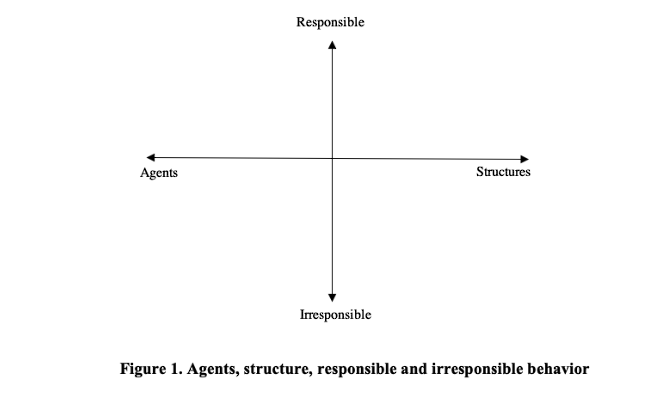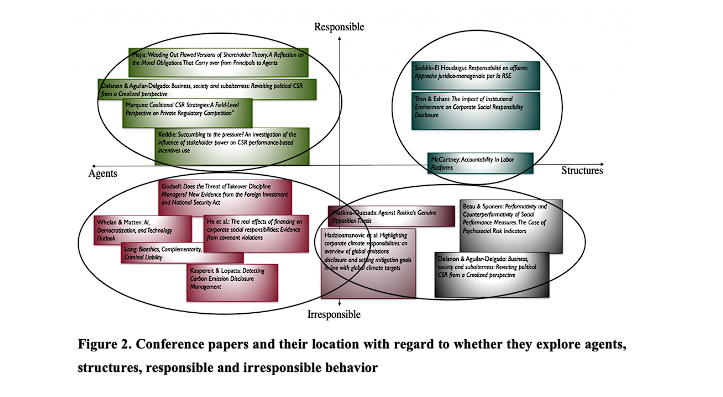On December 6 and 7 2018, we welcomed researchers to our first conference on responsibility (called “Rethinking Responsibility: Agents and Structures”) at Concordia University. The researcher came from Canada, the US, Europe and Africa; they studied business, ethics, geography, labor, law, sociology and philosophy.
Why care about responsibility?
Responsibility is important as is speaks to the role that we each play individually and as part of a collective in societal well-being and ill-being. Traditionally, societal well-being and ill-being has been measured using economic indicators like GDP per capita. Such measures are, however, insufficient, as they fail to pick up salient aspects of well-being and ill-being, such as access to health care, life expectancy, violence, social justice. This point is developed in a report issued by the OECD in late November 2018, where Nobel Laureate Joseph Stiglitz, Jean-Paul Fitoussi and Martine Durand explained why and how we need to move beyond indicators like GDP. Perhaps best illustrating the problems with such indicators was the late Robert F. Kennedy who, in 1968, pointed out that gross national product “measures everything in short, except that which makes life worthwhile”
It is fitting that our conference started on December 6. Twenty-nine years on that day, on December 6 1989, fourteen women were gunned down and murdered at the École Polytechnique de Montréal. This was an act of utmost violence. It is issues such as violence, inequality, fairness and social justice that we are concerned with when are speaking about societal well-being and ill-being, and when we are think about responsibility toward well-being and ill-being.
Why rethink responsibility?
Responsibility in the business world has almost been completely captured by the concept of Corporate Social Responsibility (CSR). We question whether CSR is sufficient, for two reasons.
- CSR is often symbolic: firms can merely pretend to engage in CSR activities yet fail to take real actions. Enron, for instance, earned several awards for its corporate governance, even though its actions were far removed from what good corporate governance would have implied. Firms can engage in different symbolic activities, including green-washing or pink-washing.
- CSR can be incomplete: firms can fail to consider the implications of their actions for all stakeholders potentially affected and, instead, focus on selected polities, such as shareholders. For example, cosmetics firms support the fight against breast cancer, yet they market products whose ingredients are associated with cancer (e.g., endocrine disruptors). A zero paper policy may seem attractive for avoiding cutting down trees, yet it requires servers on which documents are stored, and such servers consume enormous amounts of energy.
Because CSR can be symbolic and incomplete, it is insufficient to use it as the only yardstick for thinking about organizational responsibility. In this conference, we aimed to move beyond CSR by engaging with responsibility more broadly. We started our engagement by laying out the terms that characterize the conference theme: responsibility, agents, structures, rethinking. We will now discuss each term.
What is responsibility?
We each seem to intuitively understand what it means to be responsible and irresponsible. For example, financial fraud is irresponsible. Less intuitive is a definition of responsibility, no less a definition we can all agree on.
We turned to philosophy for a definition of responsibility. In her book Responsibility for Justice, the late philosopher Iris Marion Young argued that “a responsible person tries to deliberate about options before acting, makes choices that seem to be the best for all affected, and worries about how the consequences of his or her action may adversely affect others.” (Young 2011, 25). In this definition, four points are worth stressing.
- Responsibility is forward-looking: responsibility concerns future practices and actions that a person will engage in. Responsibility is different from accountability, which is looking to the past in that it holds a person to account for past actions.
- Responsibility is concerned with consequences, and these consequences consider all possible actors affected by what a person thinks about doing. In other words, the relevant polity for discussing responsibility is not defined by law (e.g., shareholders who are residual claimants of a firm), nor by norms (e.g., constituencies that are given or denied attention by norms, such as a firm’s women employees) but by who is affected, independent of law and norms.
- Responsibility supposes individual reflexivity: a person is aware that their actions have repercussions, and they reflect on these repercussions for all involved. Self-reflection supposes an interest in repercussions, and a person who does not care about the consequences of their actions will not take the time to engage in such reflection.
- Responsibility engages the individual, the person who is able to reflect. Corporations, and organizations more generally, by definition cannot reflect; only individuals who constitute corporations and organizations can do so.
What are structures?
Structures define and delimit the set of possibilities that characterize actions and practices of agents. Young (2011) argues that structures “describe a set of socially caused conditions that position a large number of people in similar ways.” (p. 18-19) Agents are subjected to structures: the action of one agent cannot change structures, at least not in the short term. However, over a longer horizon and on the level of a larger scale (i.e., multiple agents), structures can be changed. This is emphasized by Martha Nussbaum, who points out that structures refer “to the accumulated outcomes of the actions of the masses of individuals enacting their own projects, often uncoordinated with many others.” (Young 2011, XIV)
Structures include laws and regulations that require and forbid specific behaviors as well as the enforcement systems that accompany them. Structures also include norms, that is, accepted ways of being and of doing things. Norms are influenced by individual and collective actions, such as the regimes that organizations put into place (e.g., parental leave policies). Finally, structures involve cognitions, that is, mental process that individuals develop over time and that guide them in how they interpret the world around them and in how they act (e.g., gender bias).
What does rethinking responsibility involve?
We emphasize re-thinking responsibility in the context of organizations. We understand re-thinking as a re-engagement with the concept and practice of responsibility that draws on scholarship from a variety of domains, including economics, sociology, philosophy, law etc. Our intent is twofold.
- We wish to foster an awareness of the assumptions that underlie scholarship on responsibility. Such an awareness is beneficial in that it points to the limitations of applying scholarship to practical scenarios. For example, this awareness can reveal cases where assumptions that underlie scholarship do not hold. It is also beneficial as it opens avenues for developing work on organizational responsibility by pointing to areas where our understanding needs to be improved.
- We wish to encourage an engagement with the concept and practice of organizational responsibility that is not limited by the scope of a particular research paradigm. Instead, this engagement should thrive on the complementarities that can exist between research paradigms, such as the agency-centric view of economics and the structure-centric view of sociology.
Our conceptual framework
The conceptual framework that we rely on for rethinking responsibility can be represented on a graph that involves two axes, in Figure 1. The horizontal axis refers to agents and structures, and it captures the notion that an actor can be more or less agentic (i.e., an individual is more agentic than an organization). The vertical axis refers to responsible and irresponsible behavior, and it captures the notion that responsibility exists on a continuum that stretches from responsible to irresponsible behavior.


Quadrant 1 (top left): Agents and Responsibility
Papers in Quadrant 1 view agents act as collectives of individuals, such as firms and groups (e.g., managers, shareholders, minorities). They also view agents as behaving in a responsible manner. These papers all face the challenge of symbolic & incomplete responsibility. For instance, they could discuss whether agents’ actions might be symbolic.
Quadrant 2 (top right): Structures and Responsibility
Papers in Quadrant 2 consider structures as restrictive since they lead agents to do things the latter would otherwise not do. Structures, here, include legal systems, norms/cultures, organizations. The papers also consider that structures can encourage responsibility (e.g., when firms disclose more information, engage in more CSR, encourage worker accountability). These papers, as well, face the challenge of symbolic and incomplete responsibility. For instance, they could discuss who else, beyond the actors considered in the paper, are affected in important ways by structures.
Quadrant 3 (bottom right): Structures and Irresponsibility
Papers in Quadrant 3 are concerned with how structures (e.g., organizations, regulation, social context) create conditions in which irresponsible behavior occurs. Papers illustrate how structures can have detrimental effects, yet fail to question the role of structures and of individual/collective contributions to structures in irresponsible behavior. Structures can foster irresponsible behavior by offering agents a scapegoat that they can blame, thereby absolving agents from reflecting on their contribution to responsibility (Young 2011). Papers, here, face the challenge of the absolution trap in that they risk designating structures as scapegoats yet fail to discuss agents’ contributions to these structures.
Quadrant 4 (bottom left): Agents and Irresponsibility
Papers in Quadrant 4 deal with agential behavior that is irresponsible in that agents are mostly self-centered and engage in practices that improve their own welfare at the expense of that of other stakeholders (e.g., a firm cuts CSR activities when it faces financial shortfalls). Such practices illustrate symbolic and incomplete CSR. These papers generally do not designate the individuals behind the agents; instead, they speak of the organization as the acting entity. Yet, individuals are those who act, and organizations can be seen as collectives of individuals. It is through collectives of individuals, within which each individual acts, that organizations can be seen as acting (e.g., to induce change), as illustrated by several papers.
The 2018 conference on responsibility was organized by Professor Claudine Mangen, RBC Professor in Responsible Organizations, Director of the Luc Beauregard Centre of Excellence in Communications Research and by Professor Cédric Lesage, Lawrence S. Bloomberg Chair in Accountancy.
Photo adapted from Thomas Hawk








